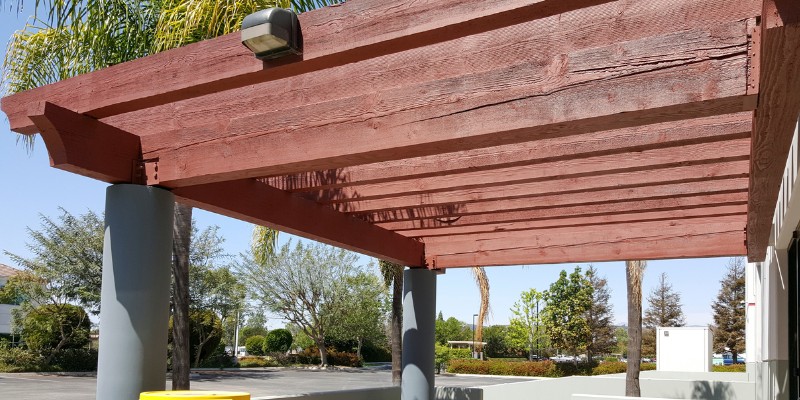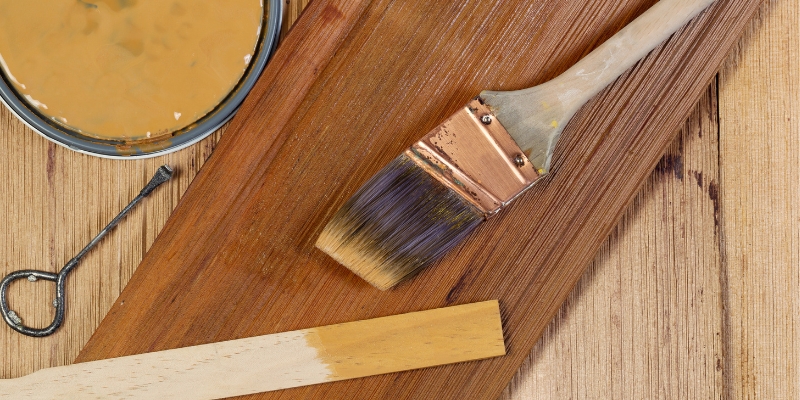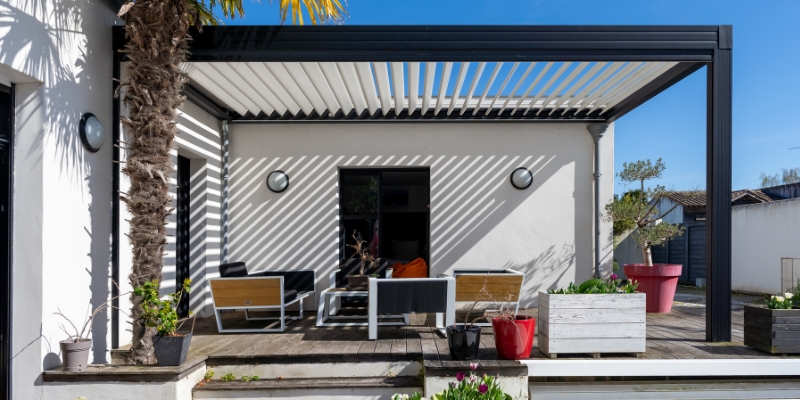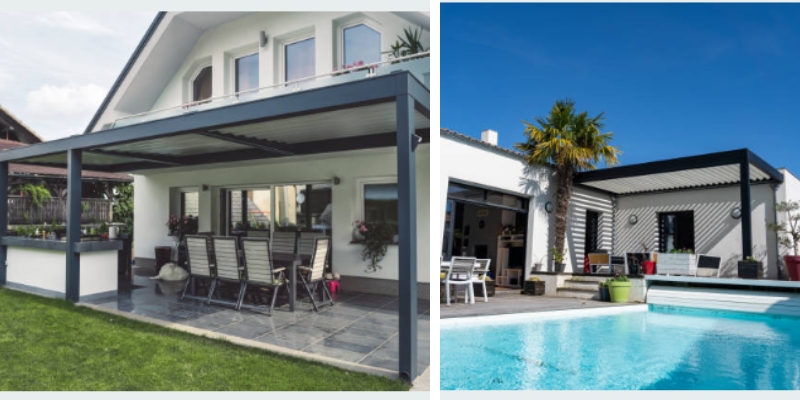With our guide on how to stain a pergola, you will discover the step-by-step process of preparing the surface, choosing the right stain, and applying the coating effectively to enhance your pergola using a deck stain.
Whether you’re a seasoned DIY enthusiast or a beginner looking to apply stain to your pressure-treated wood pergola, we’ll provide you with easy-to-understand instructions and valuable tips to make your staining project a success.

How To Prepare Pergola for Staining and Sealing?
1. Cleaning the Pergola
Before we begin discussing how to stain a pergola, it’s crucial to thoroughly clean your pergola.
Start by mixing a mild detergent or specialized pergola cleaner with water in a bucket. Using a soft brush or sponge, scrub the surface of your wood pergola to remove previous stains and any dirt, dust, or grime that may have accumulated over time.
Pay special attention to the corners, crevices, and hard-to-reach areas. Rinse the pergola thoroughly with clean water to remove any soap residue.
2. Repairing and Inspecting
After cleaning, check the pergola for loose or broken sections.
Check for loose screws, nails, or fittings and tighten or replace them. Take time to fix fractures, splinters, and damage. Sand and fix gaps with wood filler for a smooth finish.
Keep in mind, repairing and inspecting the pergola maintains its structural integrity and appearance.
3. Sanding the Surface
The pergola must be sanded for a nice finish.
Sand the wood carefully with sandpaper or a block, concentrating on rough spots. Sanding removes stains and sealer, plus smooths wood grain.
This stage cleans and prepares the surface for the next coat and sealant.
Highly recommend to use a soft brush or cloth to remove dust and debris after sanding.
How to Stain a Pergola Frame
To ensure a successful pergola staining process, it’s important to first prepare your pergola frame as discussed in the previous section, and make sure you have pressure-treated lumber.
Once you have cleaned the surface and removed any existing debris or previous coatings, you can proceed with the staining process with these easy steps.
I. Choosing the Right Stain
First of all, choose from oil-based and water-based pergola stains. An oil-based stain may be superior for durability and lifespan, especially in severe climates.
Pergola color, transparency, and protection should also be considered.
Solid stains may disguise wood defects and provide a more solid tone. They cover well and give your pergola a consistent, opaque finish.
Choose a stain that is designed for outside wood surfaces and has UV protection to prevent fading. Also, make sure the stain works with your pergola frame’s wood.
Whether you choose a regular or solid stain, you may increase the beauty and lifespan of your pergola while enjoying the ideal color and protection.
II. Applying the Stain
Use a fresh brush or roller, and apply the wood stain evenly to the pergola frame, working in small sections to avoid lap marks.
Start from the top and work your way down and, follow the direction of the wood grain.
Ensure thorough coverage and pay extra attention to areas prone to moisture exposure, such as wood pores, joints, and end grains.
If desired, apply multiple coats of stain to achieve a deeper color or richer finish, allowing sufficient drying time between each coat as per the manufacturer’s instructions.
You can also apply just one coat. This approach is often used when time or budget constraints are a factor, or when a more translucent or natural look is desired.
However, it may result in a less uniform appearance and may not provide as much protection or longevity.
III. Wiping off Excess Stain
Wipe the damp wood edge with a clean towel or rag after staining.
This process prevents wood stain blotting and uneven drying.
To produce a smooth, uniform stain, combine and apply it evenly and eliminate drips and pooling.
IV. Allowing the Stain to Dry and Cure
Allow the stain to dry thoroughly per the manufacturer’s recommendations. Ensure appropriate airflow while drying for faster, more uniform drying.
Wait the appropriate time before exposing the pergola frame to severe use or adverse weather once the stain dries.
V. Apply Sealer At Last
A pergola sealer protects the stain from fading, cracking, and peeling from sunshine and weather.
The sealant repels dirt and stains, making wood simpler to clean and preserve.
Some stains include protective ingredients, so they don’t need a sealer. To prolong the life and beauty of your stained pergola, seal it after staining.
Always follow the manufacturer’s recommendations for your stain and sealer materials to ensure correct application and compatibility.
Best Pergola Stain Colors
When it comes to staining a wooden pergola, there are various color options to consider that can enhance the overall aesthetic of your wood pergola and outdoor space.
Remember, when selecting a stain color, it’s essential to consider the type of wood used for your pergola project and test the stains on a small, inconspicuous area to ensure you achieve the desired result.
Here are some popular top stain options and colors that work well for pergolas:
1. Natural Cedar
This timeless and classic stain color brings out the natural beauty of wood and any other exterior wood surfaces, giving your pergola deck a warm and inviting look. It complements various outdoor furniture settings and blends seamlessly with the surrounding nature.
2. Rich Mahogany
If you’re aiming for a more sophisticated and elegant appearance, a rich mahogany stain can add depth and richness to your pergola. This deep reddish-brown hue creates a luxurious feel and pairs well with lush greenery.
3. Dark Walnut
For a touch of drama and a contemporary vibe, consider a dark walnut stain. This deep brown color adds a modern twist to your pergola, making it a striking focal point in your outdoor living space.
4. Gray or Weathered Finish
If you prefer a more rustic or coastal look, a gray or weathered stain can create a beautifully weathered appearance. It mimics the patina of aged wood, giving your pergola a charming, weathered appeal.
5. Painted Finish
While stains enhance the natural beauty of wood, some homeowners opt for a painted finish to match their overall outdoor decor. Choose a paint color that complements your home’s exterior or creates a striking contrast to make your pergola stand out.
Why is Staining and Sealing Wood Important?

Needless to say, maintaining the beauty and durability of your wood pergola requires staining and sealing. Wood is sensitive to dampness, UV radiation, and insects. Moreover, wood deteriorates, warps, fades, and becomes susceptible to rotting and insect damage without protection.
So, staining your wood pergola is multipurpose.
- It first boosts aesthetics by deepening, richening, and coloring the wood grain. To coordinate your outside setting, you may select from several stain colors. Refinishing your pergola lets you choose a translucent stain to highlight the wood’s inherent beauty or a solid stain to add color.
- Second, staining prevents moisture. Water absorption by wood in rain, snow, or excessive humidity causes swelling, warping, and decay. An excellent stain creates a water-resistant covering that keeps wood dry and strong.
- The third point, staining and sealing wood also prevents UV radiation. UV radiation fades wood. UV inhibitor stains protect your wood pergola from sunlight, retaining its color and structure.
- Finally, additional protection from sealing the dyed wood increases its longevity. A transparent sealer shields the wood from moisture, filth, and other pollutants. It also reduces cracking, splitting, and checking caused by weather-induced wood expansion and contraction.
When to Stain or Seal a Wood Pergola
Maintaining the beauty and durability of your wood pergola requires knowing when to stain or seal it. The age of the pergola, the wood used, and local weather determine the best time for this maintenance operation.
Keep in mind:
A newly erected wood pergola should wait a few months before staining or sealing. This lets the wood properly acclimatize and release moisture. Waiting ensures the timber is stable and ready for the protective coating.If your pergola was stained or sealed, watch for wear and weathering. The fading tint, water absorption, or dry, cracking wood indicate a new application. Regular maintenance inspections might reveal when the protective layer requires replacing.
Weather affects the staining and sealing schedule. Staining or sealing is best done in dry, warm weather. Doing it in excessive heat, cold, or humidity might reduce coating efficacy and drying time.
Is It Better To Stain or Paint a Pergola?
Choosing between staining and painting your pergola depends on various things. Both methods have merits, however, painting, from my perspective, your pergola may be more appealing.
Unfinished wood pergolas look best stained since it shows off the wood’s inherent beauty. It looks rustic and earthy while protecting against the outdoors.
Stains let you choose a color while preserving the wood’s inherent beauty. Staining takes minimal prep, making it appealing to DIYers.
However, painting your pergola gives you additional color options and a more consistent look. Painting your pergola with the same colors as your home or outside space is more versatile.
Painting same like staining also protects your pergola against moisture, UV rays, and other external elements, increasing its longevity.
Now:
Aluminum pergolas are a good alternative to staining and painting, depending on personal tastes and desired results. These pergolas are special since they don’t need staining or painting. They look good and last long thanks to their powder coating.
Do Aluminum Pergolas Also Need Staining?
Powder coating aluminum pergolas improve their appearance and durability, replacing staining.
Aluminum pergolas are resistant to air dampness and UV radiation and have a factory-applied powder coating in a variety of colors. This coating adds color and resists fading, peeling, and chipping.
The powder coating method includes baking a dry powder over metal to generate a strong, protective layer. This means you may stain your aluminum pergola in natural wood tones, earthy colors, or bold and brilliant colors.
It adds beauty and protects your pergola from the weather.
How Often Should I Stain My Pergola?
Wood type, temperature, and exposure to the environment determine how often you should stain your pergola. Pergolas should be stained every 2-3 years. Certain variables may require more frequent staining.
You may need to stain your pergola more often if you live in high heat, cold, or rain. These circumstances promote wood wear and decay, necessitating more regular care.
You should also examine the stain kind. Transparent or semi-transparent stains may need more frequent reapplication than solid color stains. Transparent stains seem more natural but may require more maintenance to retain their beauty and protection.
Keep in mind, monitoring your pergola’s status and taking action is the best strategy. If there are symptoms of degradation or it’s been years since the previous staining, arrange for a second coat. You can keep your pergola beautiful, safe, and long-lasting by being vigilant about its upkeep.
Conclusion
Finally, staining a pergola is satisfying and necessary for its upkeep. This entire instruction will help you prepare your pergola, pick a stain color, apply it properly, and protect it for long-term durability.
Whether you have a wood pergola that needs staining or an aluminum pergola that doesn’t, maintaining it will extend its lifespan and keep it looking great.


